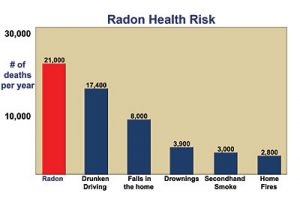 RADON
RADON
Home inspectors are often asked about radon so I thought here would be a good place to address some of the most common questions asked. Understanding the details of radon gas and its inherent risks can be difficult. I hope that by addressing the basics here, that you will be able to make an informed decision as to the best choices to make on this important topic. The answers to these questions were gathered from information provided by the EPA and the National Cancer Institute. For more detailed information I encourage you to follow the links below. If you take just one thing away from this page let it be this: TEST YOUR HOME! The EPA recommends that a radon test be conducted when purchasing a home and every two years thereafter. The best way to do this is by means of a long term test, however when this is not possible or you are looking for a quick assessment a short term test using a continuous radon monitor is the next best thing. This test requires a minimum of 48 hours. Upon retrieval of the equipment average radon levels can be provided instantly. Pro-Tech Consultants uses one of the finest monitors on the market the Radstar RS-800 which is known for its high level of accuracy and reliability. We are committed to assisting you in this matter. Please feel free to call us at 781.643.6300 should you have further questions or would like a quote for radon testing.
WHAT IS RADON AND WHERE DOES IT COME FROM?
Radon is a cancer causing radioactive gas. It can’t be seen, it has no odor or taste. Radon is released as a result of the normal decay of Uranium that is found in virtually all soil and rocks. It is present in nearly all air that we breathe though in most instances diluted to such a degree that it poses no real harm. The cause for concern arises when radon levels of 4 pCi/L (picocuries per liter of air) or higher are present within the home. It is estimated that about 1 out every 15 homes in the U.S. has actionable levels. According to the EPA radon is the second leading cause of lung cancer in the United States and is responsible for thousands of deaths each year.
How does it get into a house?
As Uranium breaks down it rises up through the soil and enters the air within the home by means of various cracks and penetrations in the basement floor and walls. If your home gets its water from a well this to could be a source for radon to enter a home.

- Cracks in basement floor.
- Spaces behind brick veneer walls that rest on uncapped hollow-block foundations.
- Pores and cracks in concrete blocks.
- Floor-wall joints.
- Exposed soil, as in a sump or crawl space.
- Weeping (drain) tile, if drained to an open sump.
- Mortar joints.
- Loose fitting pipe penetrations.
- Open tops of block walls.
- Building materials, such as brick, concrete, rock.
- Well water.
Test Your Home!
The EPA recommends that all homes be tested. The best way to do this is by means of a long term test, however when purchasing a home you don’t have this option. A short term test is the next best thing and will usually require that test vials be left in the home for a minimum of 48 hours. For clients of Pro-Tech Consultants Home Inspections the fee for a double vial scintillation kit is $75.00 After you move in to your new home you can conduct a long term test.
If high levels of radon gas are discovered in the house can anything be done?
Your test results come back with readings of 4 pCi/L or more. While this is cause for concern, and action should indeed be taken, do not panic! Conduct a second test and should the results once again confirm the previous readings corrective steps should be taken. The installation of radon mitigation systems has proven to be very effective in dealing with such problems. Typically such systems cost between $1200.00 and $2000.00. A fully certified radon mitigation specialist should install all such systems.
Should I be concerned if the home I am considering has a radon mitigation system?
The presence of such a system suggests that a problem exists but is being dealt with. As mentioned a properly installed system can effectively mitigate radon gas levels within the home. Be aware of several things: 1. Mechanical components do fail. Verify that vent fan is functional. Find out when the system was installed. Vent motors usually last about 10 years. If the system is approaching or surpassed the ten year mark then you should anticipate the need for replacement of this component. 2. Have the system inspected by a qualified specialist. 3. Whether the home has a mitigation system or not, you should CONDUCT A RADON TEST!
For further information on this topic please see the brochure: “Home Buyer’s and Seller’s Guide to Radon”
Understanding Radon:
A Citizens Guide to Radon:
http://www.epa.gov/radon/pubs/citguide.html
NRPP (National Radon Proficiency Program):
http://www.nrpp.info/
Radon and Cancer:
http://www.cancer.gov/cancerTopics/factsheet/Risk/radon
